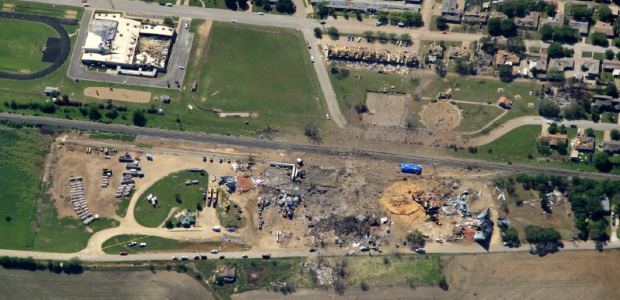
Pre-Incident Planning for Hazmat Emergencies
One of the CSB's recommendations to FEMA following the explosion in West, Texas, was to fund training for fire departments on pre-incident planning for fires at facilities storing fertilizer grade ammonium nitrate.
- By Jerry Laws
- Jul 01, 2018
Two years ago, on July 15, 2016, the U.S. Chemical Safety Board (CSB) added Emergency Planning and Response to its list of "Most Wanted Safety Improvements," based on the board's conclusion that inadequate or poor emergency planning or response has been a recurring finding in CSB’s investigations.
The board announced then that Board Member Manuel "Manny" Ehrlich would serve as the champion for the issue and quoted his reason: "As a 50-year veteran of the chemical industry, I know far too well the importance of a robust emergency response program. I have responded to and investigated numerous chemical incidents in my career and look forward to sharing the important safety information in CSB reports and safety videos."
In an AIHce EXP 2018 presentation, Bob Campbell, PE, president and CEO of Alliance Solutions Group, Inc. (https://www.asg-inc.org/, Newport News, Va.), discussed the CSB's action and the need for pre-incident planning in order to prevent hazardous materials calamities. He discussed several major incidents, including the West, Texas, ammonium nitrate fire and explosion in 2013 and an April 2014 derailment in Lynchburg, Va., of a train transporting crude oil.
The NFPA 1620 standard, Recommended Practice for Pre-Incident Planning, updated in 2015, figured prominently in Campbell's presentation. It is intended to help responders manage emergencies effectively so that occupants and response personnel are protected. As he explained, pre-incident planning is necessary because there are gaps and overlaps in current regulations affecting hazmat movement and storage, including regulations from OSHA, EPA, DOT, and DHS. There are also industry consensus standards to consider.
Campbell described pre-incident planning as a collaborative process that involves data collection, plan preparation, documentation, distribution, training, and subsequent plan revisions. His list of pre-incident planning elements included these:
- physical/site characteristics
- occupant considerations, including any on-site emergency organization
- engagement of the whole community
- water supplies and fire protection systems
- hazardous materials, including transient hazmats, such as hazmats in railcars and in pipelines
- emergency operations
His recommended best practices for preparing for and responding to hazardous materials emergencies included developing pre-incident action plans; unified command; and making use of evacuation maps and the federal Pipeline and Hazardous Materials Safety Administration's Emergency Response Guidebook, which is distributed free of charge to emergency responders through state emergency management coordinators.
Pre-incident planning can prevent a crisis from becoming a disaster, Campbell stressed.
Pre-Incident Planning Cited in CSB's West Recommendations
CSB's final report on the West fire and explosion contained a total of 19 recommendations, including four to the Federal Emergency Management Agency. One of these asked FEMA to provide competitive funding for training regional, state, and local fire departments—both career and volunteer—on how to respond to fires at facilities storing fertilizer grade ammonium nitrate, or FGAN. Another recommendation listed objectives this training should address:
- previous FGAN fires and explosion and lessons learned from them
- hazards posed by other materials and chemicals stored near FGAN, including incompatibilities of FGAN with those materials and chemicals
- pre-incident planning for fires involving FGAN
- on-scene emergency response and decision making requirements for FGAN fires, including risk assessment, scene size-up, and situational awareness
- National Incident Management System and Incident Command System
According to the recommendations information1 available on CSB's website, FEMA in July 2016 announced a funding opportunity for training in various formats on hazardous materials, with the hazmat applicants also directed to propose training that focuses on the issues related to FGAN. And on Sept. 16, 2016, FEMA awarded two $1 million grants to the Georgia Tech Research Institute and the International Association of Fire Fighters to develop and deliver hazmat training that is focused on FGAN hazards.
Based on these FEMA actions, the Chemical Safety Board judged that FEMA had gone "above and beyond the expectations" for the two recommendations and voted to designate both recommendations as "Closed—Exceeds Recommended Action."
Fifteen people died in the explosion, including a dozen volunteer firefighters.
When CSB added Emergency Planning and Response as a Most Wanted Safety Improvement, the agency had conducted 12 investigations and issued 46 recommendations intended to address deficiencies found in a community’s, facility's, or emergency responder's response to an incident at a chemical facility, the agency reported, adding that its recommendations department determined the majority of CSB's recommendations on this issue could be categorized in these six areas:
- training for emergency responders, including hazmat training
- local emergency planning and community response plans and teams
- use of community notification systems
- use of an incident command system and the National Incident Management System
- conducting emergency response exercises
- information sharing between facilities, emergency responders, and the community
References
1. https://www.csb.gov/recommendations/?F_InvestigationId=3577
2. www.nfpa.org
This article originally appeared in the July 2018 issue of Occupational Health & Safety.